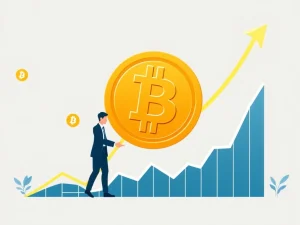Bitcoin Surge: How the Fed’s Staggering $100B Loss Rocked the Crypto Market

The financial world is buzzing with a fascinating paradox: the U.S. Federal Reserve, the bedrock of traditional finance, has reported a staggering $100 billion loss. This unprecedented event has sent ripples through global markets, directly influencing a significant Bitcoin surge even as the broader crypto market experiences a dramatic contraction. What does this mean for your investments, and is Bitcoin truly becoming the digital gold many believe it to be?
The Fed’s $100 Billion Quandary: What Sparked the Loss?
The Federal Reserve, often seen as an unshakeable pillar of economic stability, faced an astonishing $100 billion loss in mid-2025. This significant Fed loss has ignited intense scrutiny and debate about its current monetary policy framework. But how did such a massive deficit occur?
- High-Interest Rate Environment: A primary driver of the loss was the prolonged period of elevated interest rates. As the Fed raised rates to combat inflation, the cost of interest payments on reserves held by commercial banks and reverse repo operations soared.
- Chair Jerome Powell’s Leadership: Critics attribute a portion of this financial strain to decisions made under Chair Powell’s tenure, emphasizing the need for a comprehensive review of the Fed’s practices, similar to investigations that would be triggered in other federal agencies.
- Sustainability Concerns: This loss has sparked serious discussions about the long-term sustainability of traditional fiat systems, particularly when central banks struggle to manage inflation amidst complex bond market dynamics.
Why Did the Bitcoin Surge Coincide with Central Bank Woes?
Amidst the Federal Reserve’s financial struggles, Bitcoin demonstrated a remarkable Bitcoin surge. This wasn’t a mere coincidence; it reflects a growing trend where investors view the cryptocurrency as a viable alternative to centralized financial systems. Here’s why:
- Decentralized Alternative: As confidence in traditional fiat systems wavers, Bitcoin’s decentralized nature and capped supply of 21 million coins offer an inherent safeguard against inflationary pressures, a stark contrast to the Fed’s challenges.
- Rate Hike Pause: The Fed’s decision to pause rate hikes stabilized yields and weakened the U.S. dollar. This created a favorable environment for risk assets like Bitcoin, making it more attractive to investors.
- Institutional Inflows: Major asset managers, including BlackRock and Fidelity, contributed to a significant $5 billion surge in institutional inflows into Bitcoin futures ETFs. This indicates a clear shift in investor preferences towards digital assets as a hedge against currency devaluation risks.
Navigating the Crypto Market Contraction: A Closer Look
Despite Bitcoin’s impressive rally, the broader cryptocurrency market experienced a substantial crypto market contraction. This highlights the inherent volatility and interconnectedness within the digital asset space. What led to this downturn?
- Failed Resistance Breach: After an attempt to break the $120,000 resistance level in 2025, Bitcoin’s price dipped below $116,000, triggering a chain reaction across the market.
- Altcoin Liquidations: The decline was largely driven by widespread altcoin liquidations, as investors reacted to Bitcoin’s dip and broader macroeconomic shifts. This domino effect showcased the sector’s sensitivity to external factors.
- Speculative Nature: While Bitcoin’s narrative as a hedge against central bank failures is gaining traction, its speculative nature and scalability challenges still limit its immediate viability as a mainstream alternative for everyday transactions.
Monetary Policy Crossroads: Impact on Digital Assets
The current state of global finance is at a critical juncture, with central banks facing unprecedented challenges. The Federal Reserve’s recent losses underscore the complexities of modern monetary policy and its far-reaching effects on all asset classes, including cryptocurrencies.
The interplay between the Fed’s struggles and Bitcoin’s trajectory reflects broader structural uncertainties. A Brookings policy analysis observed that regulatory easing in crypto markets has inadvertently created a “less stable fiat environment,” potentially benefiting the digital asset sector as confidence in traditional systems wanes. However, the Fed’s challenge remains: how to balance inflation control with restoring trust in its tools. This delicate balance will continue to shape global capital flows and influence investor sentiment towards both traditional and digital assets.
The Promise of Decentralized Finance Amidst Uncertainty
The rise of decentralized finance (DeFi) is more than just a technological innovation; it’s a philosophical response to the vulnerabilities exposed in traditional financial systems. As central banks grapple with losses and policy dilemmas, DeFi offers an alternative vision based on transparency, autonomy, and censorship resistance.
While the path forward for DeFi is not without its own challenges, including scalability and regulatory clarity, the growing institutional interest and retail adoption suggest a fundamental shift. Investors are increasingly seeking assets that are not beholden to the whims of central authorities. However, caution remains paramount. Both traditional markets and the burgeoning digital asset space are subject to significant volatility and policy uncertainties. A well-informed approach, focusing on risk management and diversification, is crucial for navigating this evolving financial landscape.
Conclusion: Navigating a Shifting Financial Landscape
The story of the Federal Reserve’s $100 billion loss and the subsequent Bitcoin surge, followed by a broader crypto market contraction, is a vivid illustration of the complex forces at play in today’s global economy. It underscores the growing appeal of decentralized alternatives in times of traditional financial instability, yet also reminds us of the inherent volatility within the crypto space.
As central banks navigate challenging monetary policy decisions and the world grapples with inflation, digital assets like Bitcoin continue to carve out their niche. Investors must remain vigilant, understanding that while the narrative of Bitcoin as a hedge against fiat system failures gains momentum, the market’s speculative nature demands careful consideration. The financial landscape is indeed reshaping, offering both unprecedented opportunities and significant risks.
Frequently Asked Questions (FAQs)
Q1: What caused the Federal Reserve’s $100 billion loss?
A1: The Federal Reserve’s loss was primarily due to elevated interest payments on reserves and reverse repo operations, a direct consequence of prolonged high-interest rate environments implemented to combat inflation.
Q2: Why did Bitcoin surge when the Fed reported losses?
A2: Bitcoin surged because investors increasingly view it as a decentralized alternative and a hedge against inflation and currency devaluation, especially when traditional fiat systems show signs of strain. The Fed’s pause on rate hikes also created a favorable environment for risk assets.
Q3: What does ‘crypto market contraction’ mean in this context?
A3: A ‘crypto market contraction’ refers to a significant decrease in the overall market capitalization of cryptocurrencies. In this case, it was triggered by Bitcoin’s dip after failing to breach a key resistance level, leading to widespread altcoin liquidations.
Q4: How does monetary policy affect the crypto market?
A4: Monetary policy, such as interest rate decisions and quantitative easing/tightening, significantly impacts the crypto market. High rates can make risk assets less attractive, while pauses or cuts can boost them. Shifts in policy also influence confidence in fiat currencies, pushing some investors towards decentralized alternatives.
Q5: Is Bitcoin a reliable hedge against economic instability?
A5: While Bitcoin’s narrative as a hedge against central bank failures and inflation is gaining traction due to its capped supply and decentralized nature, its high volatility and speculative elements mean it still carries significant risk. It’s increasingly seen as a potential hedge but should be approached with caution and as part of a diversified portfolio.
Q6: What is decentralized finance (DeFi) and why is it gaining attention?
A6: Decentralized finance (DeFi) refers to financial services built on blockchain technology, operating without traditional intermediaries like banks. It’s gaining attention as a transparent, accessible, and censorship-resistant alternative to traditional finance, especially as confidence in centralized systems faces challenges.









